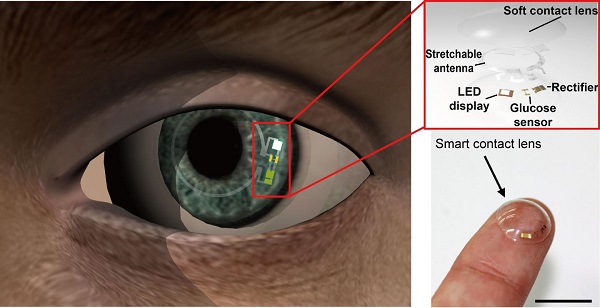A soft, flexible contact lens can monitor glucose levels in tears and deliver sensing results through the lens display, alerting the user if glucose levels are too high by turning off a tiny embedded LED light, according to a new report from UNIST, Korea.
 |
|
(Image: Jang-Ung Park, UNIST) |
The authors said their approach, tested in rabbits, is the first to apply the display pixel into a soft contact lens to visualize glucose sensing. The strategy may one day be used to screen for pre-diabetes and daily glucose monitoring. Critically, this strategy does not require the expensive tools or brittle components currently used in many "smart" lenses, which can block the user's field of vision and even harm the eye.
Such systems also typically require bulky equipment to measure signals from the contact lens sensors. To create a softer, more user-friendly smart lens capable of wirelessly monitoring glucose, Jihun Park and colleagues developed a way to incorporate into stretchy, transparent nanostructures glucose sensors, wireless power transfer circuits and, notably, display pixels capable of accessing real-time sensing data, thus eliminating the need for additional measurement equipment.
The wireless display component of their system (which contains an antenna, rectifier, and LED pixel) can respond to changing glucose levels with the help of a graphene sensor, while simultaneously displaying the glucose information through the LED pixel. After detecting the glucose level in tear fluid above the threshold, this pixel will turn off - a cue to the wearer.
To test their new device, Park and colleagues applied the lens into a rabbit eye and report they could successfully monitor an increase in glucose concentration wirelessly. They said that their hybrid substrate system can be applied to other areas, such as smart devices for drug delivery, augmented reality, and even biomarker monitoring via a smartphone.












